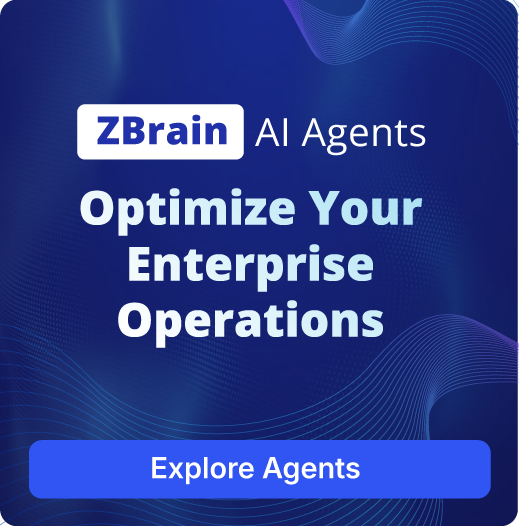AI in procure-to-pay processes: Scope, integration, use cases, challenges and future outlook

Listen to the article
The procure-to-pay (P2P) process is at the heart of business operations, ensuring seamless procurement, payment, and compliance across organizations. Yet, traditional P2P workflows often fall short—prone to inefficiencies, delays, and human errors that hinder growth and drive up costs. Enter Artificial Intelligence (AI), a game-changing technology poised to revolutionize P2P by automating repetitive tasks, improving supplier relationships, and providing actionable insights for better decision-making.
Consider this: Companies that adopt AI in procurement processes report a 30-40% reduction in invoice processing time and a 25% improvement in compliance rates. Furthermore, the application of AI has the potential to save organizations billions annually by reducing fraud, optimizing spend management, and eliminating procurement bottlenecks. It’s no wonder forward-thinking companies are turning to AI-driven solutions to stay competitive in an increasingly dynamic market.
At the forefront of this transformation are advanced AI platforms like ZBrain, with the potential to transform how businesses approach their P2P processes. ZBrain is designed to assess organizational AI readiness, identify opportunities for optimization, and provide AI-driven solutions customized for procurement workflows. By addressing tasks from requisition to payment, ZBrain helps streamline operations, minimize manual intervention, and enhance efficiency across processes.
As the adoption of AI in procurement accelerates, businesses that embrace AI will not only optimize their P2P processes but also future-proof their operations against an ever-changing business landscape. This article explores how AI transforms the P2P lifecycle, uncovers its most impactful use cases, and highlights why platforms like ZBrain are valuable for organizations seeking to stay ahead of the curve.
- What is procure-to-pay (P2P)?
- Understanding the procure-to-pay (P2P) lifecycle
- Transforming procure-to-pay: How AI solves traditional challenges
- Approaches to integrating AI into procure-to-pay
- AI applications across the procure-to-pay lifecycle
- ZBrain AI solutions for procure-to-pay use cases
- Why ZBrain is the ideal platform for procure-to-pay processes
- Benefits of implementing AI in procure-to-pay (P2P)
- Measuring the ROI of AI for procure-to-pay
- Challenges and considerations in adopting AI for procure-to-pay
- Best practices for implementing AI in procure-to-pay
- The future of AI in procure-to-pay
- Transform procure-to-pay operations with ZBrain
What is procure-to-pay (P2P)?
Procure-to-pay (P2P) refers to the end-to-end process that organizations use to obtain goods and services, encompassing all stages from initial requisitioning and supplier selection to final payment. This workflow includes creating purchase requisitions, identifying and engaging suppliers, issuing purchase orders, receiving goods, and processing invoices. By integrating procurement, finance, and accounts payable functions, the P2P process fosters a seamless and efficient workflow while ensuring adherence to organizational policies.
Although P2P serves as a framework rather than a technology, its implementation can be significantly enhanced through automation using ERP systems and specialized software. These tools reduce manual tasks, decrease errors, and provide real-time insights into procurement activities. Automated P2P workflows not only improve operational efficiency but also help maintain compliance and support better decision-making. This, in turn, enables businesses to manage costs effectively and strengthen supplier relationships.
Effectively managing the P2P process allows organizations to streamline their procurement activities, optimize resource utilization, and nurture stronger supplier partnerships. This contributes to greater operational efficiency and a sustainable approach to supply chain management.
Why is P2P important?
The procure-to-pay process is crucial for organizations because it provides a structured and integrated approach to managing procurement and financial operations. Centralizing procurement data enables businesses to make informed purchasing decisions, prevent unauthorized spending, and maintain alignment with budgets and policies. This structured approach helps mitigate financial risks and ensures that procurement aligns with strategic goals.
A well-implemented P2P system standardizes essential tasks such as generating purchase orders, reconciling invoices, and handling payments. This not only accelerates procurement cycles but also enhances the accuracy of transactions. Timely and accurate payments further strengthen supplier relationships, fostering improved service delivery and supply chain performance.
Additionally, P2P offers organizations greater visibility into financial commitments and critical performance metrics. This transparency allows businesses to analyze spending patterns, negotiate favorable supplier terms, and identify cost-saving opportunities. By optimizing the P2P process, organizations can achieve better financial management, enhanced reporting accuracy, and more strategic decision-making.
Understanding the procure-to-pay (P2P) lifecycle
Organizations tailor their procure-to-pay (P2P) processes to meet specific operational needs and align with broader business goals such as cost control, supplier relationship management, and operational efficiency. Each organization customizes its procurement strategy based on factors like availability, sustainability, and quality. Understanding the key stages of the P2P cycle is essential for optimizing the process and ensuring smooth, compliant transactions. Here’s an overview of the common stages in the P2P lifecycle:
1. Identifying the need
The P2P cycle begins when a department identifies a requirement for goods or services. This need typically arises from operational demands, such as purchasing raw materials, office supplies, or contracted services. The department specifies criteria like quantity, quality, and delivery timelines to ensure the purchase aligns with organizational objectives.
2. Requisitioning and approval
After identifying the need, a formal purchase requisition is created. This document outlines required goods or services, including specifications, quantities, and expected delivery dates. The requisition is submitted for approval to ensure alignment with the company’s budget, procurement policies, and operational priorities. The approval workflow typically involves department heads, finance teams, or procurement managers.
3. Sourcing
Once approved, the sourcing stage begins. This involves identifying potential suppliers, obtaining quotes or bids, and evaluating them based on factors like price, quality, delivery timelines, and reliability. The procurement team assesses supplier capabilities to ensure compliance with the organization’s needs and standards. This stage may also involve negotiations to secure favorable terms or bulk discounts. Key performance indicators (KPIs) are used to measure supplier effectiveness.
4. Purchase order (PO) creation
Once a supplier is selected, a formal purchase order (PO) is created and sent to the supplier. The PO serves as a legally binding agreement that specifies details like quantity, price, payment terms, delivery dates, and other conditions. It aligns both parties on the transaction details, ensuring mutual understanding and expectations.
5. Receiving
Upon delivery, the receiving department verifies the goods or services against the purchase order. This step includes checking for accuracy in quantity, quality, and condition. Any discrepancies, such as damaged goods or incorrect quantities, are flagged for resolution. Proper inspection ensures the organization receives exactly what was ordered, preventing invoicing or payment issues later.
6. Invoicing and matching
Once goods or services are received, the supplier submits an invoice. The invoice is matched with the purchase order and receiving report in a three-way match. This step confirms that the correct items were received, the invoice amount is accurate, and there are no discrepancies. This matching process helps prevent billing errors and ensures that only validated invoices are approved for payment.
7. Payment
After verifying the invoice and resolving any discrepancies, payment is processed as per the agreed-upon terms. This final step involves issuing payment to the supplier and completing the procurement transaction. Timely, accurate payments are critical to maintaining strong supplier relationships and ensuring the smooth flow of goods v and services within the supply chain.
Transforming procure-to-pay: How AI solves traditional challenges
P2P processes are critical for smooth business operations, but traditional methods often suffer inefficiencies, delays, and risks that can significantly affect performance. Issues such as manual data entry, lack of real-time visibility, invoice discrepancies, and compliance challenges are common in legacy P2P systems. Integrating AI into the P2P cycle can streamline processes, enhance accuracy, and enable better decision-making. Here’s a look at how AI addresses these challenges:
|
The challenges in traditional procure-to-pay |
Impact of traditional approaches |
How AI helps overcome this challenge |
|---|---|---|
|
Manual data entry |
Increases errors, delays, and inefficiencies. |
AI automates data entry, reducing human error and speeding up the process. |
|
Lack of visibility and control |
Difficult to track orders and payments, leading to delays. |
AI-powered tools enable real-time tracking, advanced analytics, and improved reporting for enhanced visibility and control. |
|
Invoice discrepancies |
Leads to delays, discrepancies, and the risk of late payments. |
AI automates invoice matching and approval, streamlining reconciliation and ensuring faster, error-free processing. |
|
Approval bottlenecks |
Delays in approval processes hinder speed and compliance. |
AI-driven workflows automate routing and prioritize approvals, accelerating decision-making. |
|
Lack of spend control |
Limited visibility into spending patterns and budget adherence. |
AI analyzes spending data, identifies trends, and recommends cost-saving measures. |
|
Fraud risk |
Higher vulnerability to fraud due to manual processes. |
AI detects anomalies and patterns indicating potential fraud, reducing the risk of fraud. |
|
Compliance and regulatory risks |
Increased risk of non-compliance, fines, or legal issues. |
AI continuously monitors regulations, automatically flagging discrepancies to ensure compliance. |
|
Supplier management challenges |
Difficulty in evaluating supplier performance and managing relationships. |
AI analyzes historical data to evaluate supplier performance, offering insights for better supplier selection and negotiation. |
|
Limited analytics and insights |
Lack of actionable insights into procurement efficiency and spending. |
AI provides advanced analytics, identifies trends, and offers actionable recommendations to optimize procurement strategies. |
AI enhances the procure-to-pay cycle by automating routine tasks, improving decision-making, and ensuring better compliance, resulting in smoother, faster, and more efficient procurement operations.
Streamline your operational workflows with ZBrain AI agents designed to address enterprise challenges.
Approaches to integrating AI into procure-to-pay
AI is transforming the P2P process by automating tasks, enhancing decision-making, and optimizing procurement workflows. Several approaches can be considered for organizations looking to integrate AI into their P2P systems, depending on their specific needs, resources, and goals. Below is an overview of the primary strategies for integrating AI into P2P.
Custom, in-house AI development
This approach involves building a tailored AI solution designed to address specific challenges within the P2P cycle, such as procurement forecasting, supplier management, and invoice automation. It requires developing solutions that align with a company’s unique processes and data.
Advantages:
-
Customization: Provides flexibility to address specific P2P pain points, such as customized invoice validation or supplier risk assessment.
-
Full control: Offers control over data privacy, compliance, and more, ensuring adherence to internal and industry regulations.
-
Long-term fit: The solution can evolve as the business grows, adapting to changing needs and scaling with future requirements.
Using AI point solutions
This approach leverages pre-built, off-the-shelf AI applications designed to address specific tasks within the P2P process, such as automated invoice processing, supplier selection, or spend analysis.
Advantages:
-
Quick deployment: AI point solutions can be deployed rapidly, offering immediate improvements to specific parts of the P2P process.
-
Cost-effective: These solutions typically require fewer resources to implement and are less costly than developing custom solutions from scratch.
-
Ease of use: These tools are easy to configure and integrate into existing workflows.
Adopting a comprehensive AI platform
A comprehensive AI platform integrates multiple AI capabilities into a unified environment, offering solutions across the entire P2P cycle. Such platforms, like ZBrain, often combine AI models, data management tools, and application-building frameworks to build solutions that can automate and optimize processes like spend analysis, invoice reconciliation, and supplier relationship management.
Advantages:
-
Centralized data and governance: Provides centralized control over data and processes, improving compliance with regulatory standards and ensuring data security.
-
End-to-end approach: Serves a seamless and comprehensive solution for enterprises to build, deploy, and manage AI applications without the need for extensive coding.
-
Scalability and flexibility: Easily scalable to address increasing procurement needs.
-
Efficiency: Automates complex tasks, reducing manual intervention and increasing process efficiency.
Choosing the right approach
The best approach for integrating AI into your P2P systems will depend on several factors:
-
Specific business needs: Identify which parts of the P2P cycle require AI intervention, such as supplier management, invoice automation, or spend analysis.
-
Resources and expertise: Consider the availability of internal expertise, budget for development, and technical infrastructure.
-
Compliance and security requirements: Ensure that any AI solution complies with industry regulations and adheres to data security standards.
-
Scalability and long-term goals: Choose an AI integration strategy that can grow with your business and align with broader strategic objectives.
AI applications across the procure-to-pay lifecycle
Artificial intelligence transforms the P2P lifecycle by automating tasks, enhancing decision-making, and improving efficiency. Below is a detailed explanation of AI applications across each stage of the P2P lifecycle and how AI helps in associated sub-processes level:
Procurement planning
Procurement planning involves forecasting the need for goods and services and defining budgets for procurement activities. The goal is to ensure the organization has the necessary resources while controlling costs.
-
Demand forecasting: AI uses machine learning algorithms to analyze historical data, market trends, and external factors to generate accurate forecasts, reducing overstocking or stockouts and improving inventory management.
-
Budgeting and spend allocation: AI-driven tools analyze past spending patterns and suggest optimized budget allocations based on projected needs, reducing overspending or underspending.
-
Strategic sourcing: AI can evaluate supplier performance and historical data to recommend the most suitable suppliers based on cost, quality, delivery time, and other factors, enabling better strategic sourcing decisions.
Supplier selection and management
This stage involves evaluating potential suppliers, managing supplier relationships, and mitigating risks.
-
Supplier evaluation: AI tools can analyze vast amounts of supplier data, including performance metrics such as quality, delivery speed, and compliance, to rank and identify the best suppliers.
-
Supplier risk management: AI can monitor external data, such as financial reports, news, and social media, for early signs of potential risks associated with suppliers, enabling proactive management.
-
Supplier negotiation: AI can assist procurement teams by analyzing previous negotiations and providing optimal negotiation strategies based on market trends, supplier performance, and historical pricing data.
Purchase order creation
This stage involves the creation of purchase orders (POs), ensuring that orders are accurate and meet organizational needs.
-
Purchase requisition management: AI automatically routes requisitions for approval based on predefined rules, reducing manual review times and ensuring that requisitions are properly justified.
-
Purchase order generation: AI generates purchase orders by extracting relevant data from requisitions and supplier catalogs, ensuring the orders are accurate and complete.
-
Approval workflow: AI expedites the approval process by routing orders to the correct approvers, flagging discrepancies, and ensuring compliance with organizational policies.
Invoice processing and validation
This stage involves receiving, validating, and processing invoices from suppliers to ensure they are accurate and ready for payment.
-
Invoice receipt: AI-powered OCR (optical character recognition) can extract relevant data from invoices, reducing manual data entry and improving processing speed.
-
Invoice matching: AI can compare invoice data against purchase orders and delivery receipts to detect discrepancies, ensuring accurate validation and reducing errors.
-
Approval and payment authorization: AI can flag duplicate or fraudulent invoices, streamlining the approval process and ensuring only legitimate invoices are processed.
Spend analysis
Spend analysis involves evaluating procurement data to identify trends, opportunities for cost savings, and efficiency improvements.
-
Data collection: AI can gather and integrate procurement data from multiple systems, offering a consolidated view for more effective analysis.
-
Spend categorization: Machine learning algorithms can automatically categorize procurement spend based on historical data, improving the accuracy of spend reports.
-
Spend visibility: AI can generate actionable insights from procurement data, highlighting inefficiencies, identifying cost-saving opportunities, and enabling more strategic decision-making.
Contract management
Contract management involves the creation, monitoring, and compliance tracking of contracts with suppliers.
-
Contract creation: AI can automate contract creation by pulling in standardized clauses and terms, ensuring contracts are legally sound and aligned with policies.
-
Contract monitoring: AI can monitor contract performance and deadlines, sending automated alerts for renewals and flagging non-compliance issues.
-
Contract renewal and termination: AI can predict renewal dates, track performance against agreed terms, and alert teams for renegotiation or termination.
Fraud detection
Fraud detection prevents activities such as duplicate payments, incorrect invoicing, or fraudulent suppliers.
-
Transaction monitoring: Machine learning can be used to monitor procurement transactions in real time, identifying anomalies or suspicious behavior.
-
Duplicate invoice detection: AI can flag duplicate invoices by comparing invoice numbers, amounts, and vendor details, reducing the risk of duplicate payments.
-
Anomaly detection: AI models can detect irregularities, such as unusually high pricing or abnormal order quantities, which may indicate fraud.
Payment processing
Payment processing ensures that approved payments are executed efficiently and suppliers are paid on time.
-
Payment authorization: AI can review and authorize payments by checking invoice details, payment terms, and available funds, ensuring accurate payments.
-
Payment execution: AI can automate payment scheduling, ensuring timely payments and leveraging early payment discounts.
-
Reconciliation: AI can compare payment records with invoices and purchase orders, identifying discrepancies for manual review and ensuring accurate records.
Compliance and governance
Compliance and governance ensure adherence to regulatory and internal policies throughout the procurement process.
-
Regulatory compliance monitoring: AI can track changing regulations and ensure procurement activities comply with legal and industry standards, reducing risks.
-
Policy adherence: AI can enforce organizational procurement policies by flagging non-compliant actions, such as unauthorized spending or contract deviations.
-
Audit readiness: AI can automate the collection and organization of procurement records, ensuring accurate documentation for audits and reducing preparation time.
Reporting and analytics
Reporting and analytics enable organizations to track performance and make informed decisions based on procurement data.
-
Data collection and aggregation: AI can integrate data from different sources into a unified platform, making data easily accessible and actionable.
-
Performance analysis: AI can evaluate procurement performance by analyzing key metrics such as cost savings, supplier reliability, and delivery performance.
-
Reporting: AI can automate report generation, providing real-time insights that enable more informed, data-driven decisions.
Supplier communication and support
This stage involves maintaining effective communication with suppliers and providing ongoing support.
-
Supplier query resolution: AI-powered chatbots can automatically respond to supplier queries regarding order status, payments, or other inquiries.
-
Order updates: AI can send order updates, delivery status, or changes to suppliers, enhancing communication and reducing delays.
-
Payment status: AI can notify suppliers about payment status, ensuring transparency and reducing follow-up queries.
By integrating AI across these processes, organizations can streamline the procure-to-pay lifecycle, enhance efficiency, reduce errors, and make more data-driven decisions. AI’s ability to automate tasks, predict trends, and optimize processes offers significant benefits across the procurement journey.
ZBrain AI solutions for procure-to-pay use cases
ZBrain is an agentic AI orchestration platform for building solutions to streamline, optimize, and automate various procure-to-pay (P2P) use cases. Through its components—ZBrain XPLR for AI readiness assessment and ZBrain Builder for the development and deployment of custom AI agents—ZBrain can enhance organizational efficiency and drive cost savings by addressing P2P challenges. Below is a table showcasing how ZBrain helps organizations streamline, optimize, and automate key P2P use cases, driving efficiency, and process improvements through tailored AI-powered solutions:
|
P2P use case |
Description |
How ZBrain helps |
|---|---|---|
|
Budget allocation and management |
Allocating and monitoring budgets for procurement activities to ensure financial discipline. |
ZBrain Procurement Budget Allocation Agent enables organizations to allocate procurement budgets effectively. |
|
Procurement spend analysis |
Analyzing procurement data to uncover spending trends, inefficiencies, and opportunities for cost savings. |
ZBrain Procurement Spend Analysis Agent consolidates and analyzes spend data from multiple systems, providing actionable insights to optimize procurement strategies. |
|
Supplier risk assesment |
Evaluating supplier risks based on performance, compliance, financial health, and other critical parameters to mitigate risks. |
ZBrain Supplier Risk Assessment Agent analyzes supplier data during onboarding and ongoing evaluations, providing risk scores and proactive insights to minimize potential disruptions. |
|
Supplier performance analysis |
Tracking and evaluating supplier performance to ensure consistent service quality and reliability. |
ZBrain Supplier Performance Monitoring Agent benchmarks supplier performance across metrics such as delivery times, quality standards, and cost efficiency. |
|
Supplier communication automation |
Automating routine interactions and ensuring seamless communication with suppliers for contract renewals and updates. |
ZBrain Supplier Communication Automation Agent automates supplier communications, focusing on contract renewals and routine interactions, enabling procurement teams to prioritize strategic supplier management. |
|
Purchase requisition management |
Streamlining the process of submitting and approving purchase requisitions, ensuring policy compliance. |
ZBrain solutions can automate workflows for requisition approvals based on predefined rules, reducing delays and improving efficiency. |
|
Order management |
Tracking and managing purchase orders, from creation to fulfillment, ensuring smooth procurement operations. |
ZBrain solutions can automate order processing and tracking, providing real-time updates to streamline the procurement workflow. |
|
Invoice matching |
Matching invoices with purchase orders to ensure efficient invoice processing and prevent errors. |
ZBrain Purchase Order-Invoice Matching Agent automates invoice matching by extracting, validating, and reconciling data, reducing manual efforts and errors. |
|
Procurement fraud detection |
Identifying fraudulent procurement transactions, duplicate invoices, or non-compliant activities. |
ZBrain solutions can monitor procurement transactions in real time, detecting anomalies and fraud patterns to safeguard financial integrity. |
|
Contract clause summarization |
Summarizing and reviewing key contract clauses. |
ZBrain Contract Clause Summarization Agent extracts and summarizes key clauses from lengthy procurement contracts, improving the contract review process. |
|
Contract obligation tracking |
Tracking and monitoring contract obligations to ensure adherence to agreed terms and deadlines. |
ZBrain solutions can monitor key contract milestones and obligations, providing timely alerts to prevent non-compliance. |
|
Contract template management |
Managing and generating standard contract templates to streamline the contract creation process. |
ZBrain Contract Template Management Agent automates the creation of reusable contract templates, ensuring consistency and compliance across all agreements. |
|
Procurement compliance tracking |
Tracking procurement activities to ensure compliance with internal policies and regulatory standards. |
ZBrain solutions can monitor and enforce compliance across procurement activities, flagging deviations for corrective action. |
ZBrain, with its generative AI capabilities, helps businesses automate and optimize various aspects of the procure-to-pay process.
Streamline your operational workflows with ZBrain AI agents designed to address enterprise challenges.
Why ZBrain is the ideal platform for procure-to-pay processes
ZBrain’s GenAI capabilities support organizations in optimizing various processes, including procure-to-pay (P2P). ZBrain solutions are designed to facilitate efficiency, automation, and informed decision-making in procurement workflows.
-
AI readiness assessment: ZBrain’s AI readiness assessment framework, ZBrain XPLR can evaluate an organization’s current capabilities and preparedness for AI adoption in P2P processes. It provides actionable insights that help organizations understand their strengths and areas for improvement, ensuring a smooth and successful AI implementation.
-
Low-code development: ZBrain’s low-code platform, ZBrain Builder, enables business users to create AI solutions designed to address P2P challenges without requiring extensive technical expertise.
-
Proprietary data utilization: The platform enables organizations to leverage their own data effectively, ensuring AI solutions are tailored to the specific needs and goals of their P2P operations.
-
Enterprise-ready: Built for enterprise environments, ZBrain offers robust security, scalability, and seamless integration with existing P2P systems, making it ideal for organizations of all sizes.
-
End-to-end support: ZBrain manages the entire lifecycle of P2P AI applications—from initial assessment to development to deployment and ongoing support—ensuring continuous optimization and smooth transitions.
-
Flexible data ingestion: ZBrain Builder can ingest a wide variety of data from multiple sources, ensuring that P2P applications have access to real-time, comprehensive data to improve decision-making and process efficiency.
-
Intelligent agent creation: ZBrain Builder enables the creation of AI agents that automate key tasks within the P2P process, such as invoice validation, supplier communication, and fraud detection, allowing procurement professionals to focus on strategic decision-making.
These capabilities of ZBrain help organizations manage and automate their P2P processes, focusing on efficiency, accuracy, and scalability in procurement operations.
Benefits of implementing AI in procure-to-pay (P2P)
Integrating artificial intelligence into the procure-to-pay (P2P) process can significantly transform how organizations operate, leading to enhanced efficiency, cost savings, improved decision-making, and stronger relationships across the value chain. Here’s a breakdown of the benefits for each stakeholder:
For organizations:
-
Cost efficiency
AI-driven automation reduces the need for manual intervention in repetitive tasks like data entry, invoice processing, and supplier communication, resulting in significant cost savings. By minimizing human error and automating routine processes, organizations can ensure higher accuracy and reduce costly mistakes that arise from manual handling. -
Enhanced spend visibility
AI provides organizations with real-time, actionable insights into spending patterns. This visibility allows businesses to identify cost-saving opportunities, optimize procurement decisions, and implement more effective budgeting strategies. With a clearer view of spending, organizations can better allocate resources, leading to long-term financial control. -
Risk mitigation
AI helps organizations proactively identify and address risks by continuously monitoring supplier performance, market trends, and compliance issues. This early detection of potential disruptions, such as delayed shipments or non-compliance, allows businesses to mitigate risks before they escalate, avoiding significant financial and operational consequences. -
Scalability
AI solutions scale effortlessly with business growth. As procurement volumes increase, AI can manage higher workloads without requiring additional manual labor or administrative staff. This scalability ensures operational efficiency even as an organization expands its operations, allowing procurement to keep pace with growth. -
Data-driven decision making
AI empowers businesses with insights derived from data, enabling smarter, more informed decisions in sourcing, procurement strategies, and supplier negotiations. With AI providing actionable data, organizations can align procurement processes with broader strategic goals, optimizing their approach to supplier management and contract negotiations. -
Increased operational efficiency
By automating manual tasks, AI accelerates the P2P cycle, reduces delays, and enhances processing times. Automation ensures quicker decision-making, enabling businesses to respond faster to changing needs and maintain an agile, efficient procurement process.
For employees:
-
Increased productivity
AI automates repetitive and time-consuming tasks, freeing up employees to focus on higher-value activities like strategic decision-making and supplier negotiations. This boosts overall productivity, allowing employees to concentrate on tasks that directly contribute to business growth and innovation. -
Enhanced employee satisfaction
By removing monotonous, manual tasks, AI enhances job satisfaction, offering employees the opportunity to engage in more fulfilling, impactful work. This not only improves morale but also increases employee engagement, resulting in a more motivated and satisfied workforce. -
Skill development opportunities
With AI handling routine tasks, employees have the chance to develop new skills, particularly in data analysis, strategic decision-making, and the use of AI technologies. This fosters continuous professional growth, equipping teams with the skills required to tackle future challenges and leverage emerging technologies. -
Improved collaboration
AI facilitates better communication and collaboration across departments by creating smoother workflows and providing insights into supplier performance, purchasing trends, and spend patterns. This improved transparency leads to better cross-functional decision-making, fostering a more efficient and cohesive working environment.
For customers:
-
Improved service quality
The automation and efficiencies introduced by AI in P2P directly improve customer experiences. Faster order processing, accurate inventory management, and timely payments ensure that customers receive their products and services promptly, enhancing the overall reliability and quality of the service. -
Supply chain reliability
AI-driven supplier monitoring enables businesses to proactively manage supplier performance and identify potential risks, ensuring the smooth flow of goods and services. This increased reliability helps businesses meet customer demand consistently, reduce disruptions, and maintain customer trust. -
Faster response to market changes
AI streamlines procurement processes, enabling businesses to make quicker decisions and adapt more swiftly to market changes. With AI-enabled agility, companies can respond to shifts in customer needs, trends, and market conditions, ensuring they remain competitive and relevant. -
Cost savings passed to customers
By optimizing procurement processes and identifying cost-saving opportunities, businesses can pass these savings on to customers in the form of competitive pricing. This strengthens the value proposition, improves customer satisfaction, and enhances long-term customer loyalty. -
Enhanced compliance and transparency
AI ensures that procurement processes adhere to regulatory standards and internal policies by automating compliance monitoring. This not only helps businesses maintain transparency but also fosters greater trust with customers, ensuring that organizations meet both customer and regulatory expectations.
Implementing AI in the procure-to-pay process drives efficiency and cost savings and enhances decision-making and customer satisfaction. By leveraging AI, organizations can future-proof their procurement functions, fostering long-term growth and resilience in an ever-evolving marketplace.
Measuring the ROI of AI for procure-to-pay
In procure-to-pay (P2P) processes, the return on investment (ROI) for AI can be assessed by evaluating direct cost savings, efficiency improvements, and enhanced decision-making. By implementing ZBrain, organizations can streamline procurement workflows, reduce manual intervention, and optimize supplier relationships, resulting in significant financial and operational benefits. ROI is determined by comparing automation and process optimization savings against the investment. Here’s a closer look at how ZBrain enhances ROI across key P2P use cases:
ZBrain implementation in procure-to-pay processes: Key ROI indicators
-
Automated invoice processing
-
Use case: Automating data extraction, validation, and recording of invoices into the financial system.
-
ROI metrics:
-
Reduced invoice processing costs.
-
Faster payment cycle times.
-
Lower error rates in invoice validation.
-
-
Example: ZBrain agents can streamline invoice processing by automating the extraction, validation, and recording of invoice data. By integrating with enterprise financial systems, these agents can ensure accurate and efficient processing, reduce manual intervention, minimize payment delays, and enable opportunities for early payment discounts, ultimately enhancing financial operations and supplier relationships.
-
-
Supplier management and risk assessment
-
Use case: Monitoring supplier performance and assessing risks proactively.
-
ROI metrics:
-
Improved supplier compliance.
-
Reduction in supplier risk incidents.
-
Enhanced contract performance.
-
-
Example: ZBrain agents enhance supplier management by leveraging AI to analyze supplier data, assess risks, and recommend actionable insights. By integrating with supplier management systems, these agents enable organizations to create detailed risk profiles, identify potential issues proactively, and strengthen supplier relationships, ensuring a resilient and efficient supply chain.
-
-
Spend analysis
-
Use case: Consolidating and analyzing procurement spend data across multiple categories.
-
ROI metrics:
-
Better spend visibility and control.
-
Higher cost savings through supplier negotiations.
-
Reduction in maverick spending.
-
-
Example: ZBrain agents can streamline spend analysis by integrating AI to deliver real-time insights into spending patterns and procurement categories. These agents empower procurement teams with actionable data, enabling more informed decision-making and effective supplier negotiations, ultimately driving cost efficiency and strategic purchasing.
-
-
Contract management
-
Use case: Automating contract lifecycle management, including drafting, tracking, and compliance monitoring.
-
ROI metrics:
-
Reduced time for contract creation and approval.
-
Increased contract compliance rates.
-
Lower contract-related disputes.
-
-
Example: ZBrain agents can simplify contract management by leveraging AI to generate standard contracts and monitor compliance with contractual terms. These agents ensure timely renewals, reduce legal risks and enhance the efficiency of contract administration processes.
-
-
Fraud detection
-
Use case: Identifying anomalies in procurement transactions to prevent fraud.
-
ROI metrics:
-
Decreased instances of fraud.
-
Faster detection of irregularities.
-
Reduced financial losses due to fraud.
-
-
Example: ZBrain agents can enhance fraud detection by utilizing advanced AI models to analyze transaction patterns, identify anomalies, and flag unusual activities. These agents can provide actionable insights to prevent procurement fraud, ensuring secure and transparent procurement processes.
-
-
Order processing and validation
-
Use case: Streamlining order requisition, validation, and tracking processes.
-
ROI metrics:
-
Shortened order cycle times.
-
Increased accuracy in order fulfillment.
-
Reduced manual intervention.
-
-
Example: ZBrain agents can streamline order processing by automating workflows to validate and route orders accurately. These agents can ensure timely order fulfillment, minimize delays, and reduce errors, enhancing overall procurement efficiency.
-
-
Automated approval workflows
-
Use case: Simplifying the routing and approval of purchase orders and invoices.
-
ROI metrics:
-
Faster approvals and reduced bottlenecks.
-
Lower administrative overhead.
-
Higher compliance with approval policies.
-
-
Example: ZBrain agents can streamline approval workflows by automating the routing of documents through the appropriate channels. These agents can reduce manual effort, ensure accurate approvals, and maintain timeliness, enhancing the efficiency of the procurement process.
-
-
Supplier communication automation
-
Use case: Automating routine communication with suppliers for updates, inquiries, and feedback.
-
ROI metrics:
-
Improved supplier response times.
-
Reduced manual communication effort.
-
Stronger supplier relationships.
-
-
Example: ZBrain agents can automate supplier communications by delivering timely updates and notifications, minimizing manual effort and streamlining the communication process. This enhances collaboration and improves the efficiency of supplier interactions within procurement workflows.
-
These examples demonstrate the tangible benefits of AI in reducing costs, enhancing operational efficiency, and improving processes within procurement workflows. By measuring and reporting on these outcomes, organizations can validate the value of their AI investments and identify opportunities for further AI-driven optimization across various stages of the procure-to-pay process.
Challenges and considerations in adopting AI for procure-to-pay
Adopting AI in procure-to-pay (P2P) processes can significantly improve efficiency, reduce costs, and enhance decision-making. However, several challenges need to be addressed to ensure a successful implementation. The following table outlines these challenges and how ZBrain addresses each one:
|
Aspect |
Challenge |
How ZBrain addresses these challenges |
|---|---|---|
|
Data quality and integration |
Fragmented data sources and legacy systems can hinder seamless integration and data consistency for AI. |
ZBrain Builder supports seamless data integration with existing P2P systems, ensuring data quality through preprocessing and normalization and making it easier to leverage AI effectively. |
|
Workflow automation |
Identifying which tasks to automate and managing exceptions can be complex, leading to inefficient processes. |
ZBrain’s XPLR framework, combined with its low-code agentic AI orchestration platform ZBrain Builder, can enable users to precisely identify automation opportunities and build solutions. |
|
Resistance to change |
Employees may resist adopting AI technologies due to fear of job displacement or unfamiliarity with the tools. |
ZBrain ensures smooth user adoption with AI solutions that are easy to integrate and use. |
|
Compliance and security |
Ensuring AI systems comply with regulations and protecting data privacy is critical for legal and ethical reasons. |
ZBrain ensures compliance and data security by implementing robust data protection measures, adhering to industry standards and regulations, and continuously monitoring systems to safeguard sensitive information. |
|
AI readiness assessment |
Organizations must assess their AI maturity before integrating AI-driven solutions, which is time- and resource-intensive. |
ZBrain XPLR assesses readiness to integrate AI into procure-to-pay (P2P) processes, identifying opportunities for efficiency and strategic alignment. It helps maximize ROI and minimize risks by ensuring AI initiatives support business goals. |
|
Customization and flexibility |
Standard AI tools may not address unique P2P process requirements, requiring extensive customization. |
ZBrain provides a high level of customization, allowing businesses to tailor workflows, data inputs, and AI models to suit specific P2P challenges and organizational needs. |
Streamline your operational workflows with ZBrain AI agents designed to address enterprise challenges.
Best practices for implementing AI in procure-to-pay
Implementing AI in procure-to-pay (P2P) processes offers a significant opportunity to optimize efficiency, reduce manual errors, and drive better decision-making. However, the successful adoption of AI requires thoughtful planning, stakeholder engagement, and strategic execution. Here are some best practices for implementing AI in P2P processes:
1. Assess process readiness for AI integration
Before diving into AI adoption, it’s essential to evaluate the current state of your P2P workflows to identify opportunities for improvement.
-
Map existing workflows: Conduct a comprehensive process discovery to document and understand the current P2P processes. Identify key pain points, bottlenecks, and areas where automation can drive the most value, such as invoice processing or supplier management.
-
Assess data quality and infrastructure: AI thrives on data, so ensuring your organization has access to clean, structured, and well-organized data is crucial. Conduct an audit of your data infrastructure to ensure it can support AI tools effectively.
-
Gauge change readiness: Gauge the readiness of your organization for AI adoption by engaging stakeholders through surveys, focus groups, or interviews. Understanding their concerns and expectations will help in addressing potential resistance and aligning goals.
-
Define clear goals and metrics: Set specific, measurable objectives for your AI implementation, such as improving supplier relationship management, reducing invoice cycle time, or enhancing payment accuracy. Define success metrics that align with broader business goals.
2. Leverage the right AI technology for P2P automation
AI offers several advanced technologies that can significantly enhance P2P processes. Selecting the right tools for the job will ensure maximum impact.
-
Machine learning (ML) for predictive analytics: Use ML models to predict trends such as supplier performance, demand forecasting, or potential payment delays. By analyzing historical transaction data, AI can provide insights that drive smarter decisions in procurement and payment processes.
-
Natural Language Processing (NLP): Implement NLP for automating document scanning and data extraction from invoices, purchase orders, and contracts. This reduces manual data entry and errors while streamlining document processing.
-
OCR and data extraction: Use Optical Character Recognition (OCR) to digitize and extract relevant data from paper invoices and receipts. This enables faster processing and integration with digital systems.
-
Dashboards and reporting tools: Implement AI-driven reporting tools that provide real-time visibility into key metrics, such as payment status, supplier performance, and spend analysis. These dashboards allow for better decision-making and proactive issue resolution.
3. Engage stakeholders and manage change effectively
AI adoption is not just about technology; it’s also about people. Managing the cultural shift is a key factor in ensuring successful implementation.
-
Communicate the AI strategy: Clearly communicate the purpose and benefits of AI to all stakeholders, emphasizing how it will enhance their roles and simplify their tasks. Address any concerns about job displacement and reinforce the idea that AI will enable employees to focus on more strategic, value-added activities.
-
Provide training and upskilling: Equip employees with the knowledge and skills needed to operate AI tools and interpret their outputs. Training should be ongoing, with a focus on upskilling staff on new systems and technologies.
-
Involve stakeholders early: Involve key stakeholders from procurement, finance, and IT departments early in the AI integration process. Their input and buy-in are crucial for the smooth implementation of AI systems.
-
Pilot and gradual rollout: Consider starting with a pilot phase where AI-driven P2P processes run in parallel with existing manual processes. This allows teams to become comfortable with the new system and address any challenges before full-scale deployment.
-
Monitor adoption and address resistance: Regularly track adoption rates and measure the success of AI-driven processes. Address any resistance or challenges by engaging change agents and offering ongoing support to ensure smooth integration.
4. Ensure scalability and flexibility for long-term success
The P2P landscape is dynamic, and AI implementations should be flexible enough to adapt to evolving business needs.
-
Scalability: Ensure that the AI tools and systems you implement can scale as your business grows. AI solutions should accommodate increased transaction volumes, expanded supplier networks, and more complex workflows without requiring significant rework.
-
Continuous improvement: AI systems should be continuously fine-tuned and optimized based on new data, evolving business objectives, and industry trends. Regularly evaluate the system’s performance and make improvements to maintain optimal efficiency.
-
Interoperability: Choose AI solutions that seamlessly integrate with existing enterprise systems, such as ERP platforms, to create a unified, streamlined workflow across the entire P2P process. This minimizes disruption and ensures smooth data flow between systems.
The future of AI in procure-to-pay
The future of AI in procure-to-pay (P2P) will bring significant advancements in various aspects of the procurement process. Key improvements and emerging technologies include:
-
Advanced predictive analytics
AI-driven predictive models will enable procurement teams to anticipate demand fluctuations, optimize inventory levels, and better manage supplier relationships. By analyzing historical data, market conditions, and trends, AI can predict price changes, potential disruptions, and demand surges, empowering procurement managers to make proactive decisions, minimize costs, and avoid stockouts or overstocking.
-
Self-learning AI systems
AI systems that continuously adapt and improve by learning from changing procurement patterns, market conditions, and supplier dynamics could become mainstream. This continuous learning will make AI solutions more personalized, accurate, and effective, reducing manual intervention and enhancing decision-making. -
Blockchain integration for transparency and security
AI integration with blockchain technology enhances data integrity, transparency, and security in P2P transactions. Blockchain technology will enhance the security of procurement activities, such as payments, contract executions, and supplier interactions. At the same time, AI will analyze the data stored on the blockchain to verify compliance with regulations, detect potential fraud by identifying suspicious activities, and monitor governance to ensure that procurement operations follow established rules and standards. -
Sustainability optimization
AI will help organizations align procurement decisions with sustainability objectives by analyzing environmental impact, social practices, and supplier sustainability certifications. This future capability will enable AI to recommend suppliers and products that meet sustainability criteria and track the lifecycle of products to reduce waste and optimize resource usage, supporting corporate social responsibility (CSR) goals. -
Real-time decision-making and process optimization:
AI enables real-time decision-making by analyzing up-to-the-minute data on inventory, supplier performance, and market conditions. Future AI advancements will optimize workflows such as purchase orders, supplier sourcing, and stock replenishment, offering instant insights into the best course of action based on real-time information and automatically recommending process adjustments.These advancements in AI will further transform P2P processes, enhancing agility, compliance, sustainability, and operational efficiency.
Transform procure-to-pay operations with ZBrain
ZBrain is a comprehensive AI platform designed to assist organizations in identifying automation opportunities and managing workflows within their procure-to-pay (P2P) operations. It supports the P2P lifecycle—from requisition to payment—by offering intelligent, customizable AI solutions aligned with business goals.
ZBrain XPLR empowers businesses by assessing their AI readiness, preparing them for successful AI integration. The comprehensive assessment uncovers areas for improvement and helps align AI strategies with business objectives, ensuring a smooth transition to AI-driven solutions and minimizing potential risks.
ZBrain Builder provides a suite of tools, pre-built components, and an intuitive interface to help users leverage AI agents for automating tasks within P2P processes. These agents can handle activities such as supplier communications, invoice validation, compliance, and spend analysis, all aimed at supporting and streamlining procurement operations.
By integrating seamlessly with existing systems, offering scalability, and ensuring security, ZBrain can help organizations transform their P2P operations, improve efficiency, and stay competitive in today’s rapidly changing business environment.
Endnote
The integration of AI into procure-to-pay (P2P) operations is reshaping the way organizations manage procurement processes. AI brings significant improvements across the entire P2P lifecycle, automating repetitive tasks, optimizing workflows, and providing actionable insights that enhance decision-making. This shift allows organizations to operate more efficiently, reduce manual effort, and achieve better alignment with business goals.
As AI continues to evolve, its role in optimizing procurement operations will only grow. ZBrain equips organizations to leverage AI effectively, streamlining procurement processes, enhancing operational efficiency, and positioning businesses for sustained success. Embracing AI with the support of platforms like ZBrain is crucial for organizations that want to lead in today’s dynamic and competitive business environment.
Ready to transform your procurement process with AI? Unlock the full potential of your P2P operations with ZBrain’s intelligent automation, driving efficiency, cost savings, and smarter decision-making across your supply chain!
Listen to the article
Author’s Bio

An early adopter of emerging technologies, Akash leads innovation in AI, driving transformative solutions that enhance business operations. With his entrepreneurial spirit, technical acumen and passion for AI, Akash continues to explore new horizons, empowering businesses with solutions that enable seamless automation, intelligent decision-making, and next-generation digital experiences.
- What is procure-to-pay (P2P)?
- Understanding the procure-to-pay (P2P) lifecycle
- Transforming procure-to-pay: How AI solves traditional challenges
- Approaches to integrating AI into procure-to-pay
- AI applications across the procure-to-pay lifecycle
- ZBrain AI solutions for procure-to-pay use cases
- Why ZBrain is the ideal platform for procure-to-pay processes
- Benefits of implementing AI in procure-to-pay (P2P)
- Measuring the ROI of AI for procure-to-pay
- Challenges and considerations in adopting AI for procure-to-pay
- Best practices for implementing AI in procure-to-pay
- The future of AI in procure-to-pay
- Transform procure-to-pay operations with ZBrain
What is ZBrain, and how can it transform the procure-to-pay (P2P) process with AI?
ZBrain is a comprehensive, full-stack AI platform designed to streamline the AI readiness assessment, use case identification, development and deployment of AI agents to automate the procure-to-pay (P2P) processes. From data integration and model customization to deployment and continuous optimization, ZBrain provides end-to-end support for AI implementation in P2P workflows.
Here’s how ZBrain enhances P2P processes:
-
AI readiness assessment with ZBrain XPLR: ZBrain XPLR provides a comprehensive AI readiness assessment, helping organizations evaluate their current state and identify key opportunities for AI adoption in P2P processes. It analyzes existing workflows, data quality, and system integration capabilities to ensure smooth AI integration. ZBrain XPLR guides businesses toward informed, strategic AI adoption for enhanced procurement operations by assessing AI maturity and highlighting automation possibilities.
-
Seamless data ingestion and integration: ZBrain Builder connects with multiple data sources, including procurement systems, supplier databases, and financial tools. This allows the platform to ingest structured and unstructured data efficiently, creating a unified data pipeline that ensures accurate and real-time insights.
-
Low-code development environment: ZBrain Builder provides a low-code interface, empowering procurement teams to build AI applications without extensive programming knowledge. This reduces development cycles and allows quicker deployment of AI tools tailored to specific P2P needs.
-
Cloud and model flexibility: ZBrain supports various AI models, such as GPT-4 and LLaMA, as well as cloud environments like AWS, Azure, and GCP. This flexibility ensures organizations can select the optimal infrastructure and models for their P2P processes, balancing performance and cost.
-
Enhanced compliance and governance: ZBrain’s AI capabilities assist in monitoring regulatory compliance and internal governance policies, flagging potential risks and ensuring audit readiness throughout the P2P lifecycle.
By offering a flexible, low-code platform combined with robust data handling and customization options, ZBrain empowers organizations to automate, optimize, and innovate across the entire procure-to-pay process.
How does ZBrain ensure the security and privacy of sensitive data in procure-to-pay (P2P) processes?
ZBrain is designed with a strong emphasis on data privacy and security, ensuring that sensitive information involved in P2P operations is safeguarded at all stages. Here’s how ZBrain protects sensitive P2P data:
-
Private cloud deployments: ZBrain applications can be deployed in a private cloud environment, ensuring that critical procurement and financial data is stored securely within the organization’s infrastructure and not shared with external services without explicit authorization.
-
Robust security features: ZBrain incorporates multiple layers of security to protect sensitive data, including:
-
Access controls: Granular role-based access controls ensure that only authorized personnel can view or manage sensitive P2P information.
-
Monitoring and alerts: Continuous monitoring of data access and usage with automated alerts for potential security threats or unauthorized activities.
-
-
Compliance and governance: ZBrain is built to adhere to industry-specific regulations and standards, such as ISO 27001:2022 and SOC 2 Type II, ensuring that data is handled in a manner that meets compliance requirements for confidentiality, integrity, and accountability.
By combining secure deployments, advanced encryption, strict access controls, and compliance with regulatory standards, ZBrain ensures that sensitive data within the P2P lifecycle is handled with the utmost security and privacy.
Can ZBrain agents be integrated with existing procure-to-pay (P2P) systems?
Yes, ZBrain agents are designed to integrate seamlessly with existing P2P systems. The platform supports various data formats and standards, ensuring smooth interoperability with legacy procurement, financial, and ERP systems.
This integration allows organizations to:
-
Leverage existing infrastructure: Enhance current P2P processes without the need for a complete overhaul of legacy systems.
-
Enrich data and workflows: Connect ZBrain agents with existing tools to automate workflows, streamline operations, and improve data accessibility.
-
Drive AI-driven insights: Utilize advanced AI capabilities to analyze procurement data, optimize spend, and enhance decision-making while maintaining compatibility with established technologies.
By enabling seamless integration, ZBrain ensures that organizations can modernize their P2P lifecycle without disrupting existing systems or workflows.
What kind of P2P applications can be built on ZBrain?
ZBrain enables the development of AI agents tailored to various procurement and financial processes. Whether you’re optimizing procurement workflows, automating supplier management, enhancing invoice processing, or enabling AI-driven spend analysis, ZBrain can support them all. Its advanced capabilities empower organizations to streamline procurement operations, improve decision-making, reduce costs, and enhance overall efficiency across the P2P lifecycle. With its flexibility and customization, ZBrain is the ideal platform that meets the specific needs of businesses looking to integrate generative AI solutions into their procurement processes.
How does ZBrain cater to diverse procurement needs across different industries?
ZBrain’s flexibility allows it to cater to a wide range of procurement needs across different industries. Whether you’re in manufacturing, retail, or services, ZBrain can be customized to meet your unique procurement requirements. From automating purchase order generation to streamlining invoice processing and enhancing spend analysis, ZBrain’s AI-driven solutions provide significant value across various industry sectors, helping organizations optimize their P2P processes and improve overall efficiency
How can we measure the ROI of ZBrain in our procure-to-pay (P2P) processes?
Measuring the ROI of ZBrain in P2P involves evaluating key performance indicators (KPIs) that showcase the impact of AI solutions on procurement operations. Here are some metrics to consider:
-
Cost savings: Track reductions in procurement costs due to AI-driven process automation, optimized supplier management, and improved spend categorization.
-
Efficiency improvements: Measure the time saved in procurement tasks such as purchase order creation, invoice validation, and supplier communication, enabling teams to focus on more strategic activities.
-
Faster payment processing: Evaluate the reduction in the time it takes to authorize, schedule, and execute payments, ensuring faster and more accurate processing.
-
Supplier performance improvement: Analyze how AI-assisted supplier evaluation and management enhances supplier relationships, leading to better pricing, timely deliveries, and fewer disputes.
-
Reduction in fraud and errors: Measure the decrease in fraudulent transactions, duplicate invoices, and manual errors, resulting in higher compliance and fewer financial discrepancies.
-
Spend visibility and optimization: Evaluate how AI-generated insights provide a clearer view of procurement spending, leading to smarter decisions, cost-saving opportunities, and improved budget allocation.
By tracking these KPIs, organizations can quantify the efficiency, cost-effectiveness, and overall value that ZBrain brings to the procure-to-pay process, justifying ongoing investments in AI-powered P2P automation.
How can I get started with ZBrain for my procure-to-pay (P2P) processes?
To begin using ZBrain for optimizing your P2P processes, simply reach out to us at hello@zbrain.ai or fill out the inquiry form on our website. Please include your name, work email, phone number, company name, and specific P2P needs. Our team will get in touch with you to explore how our platform can integrate with your existing procurement systems and streamline your P2P workflows.
Insights
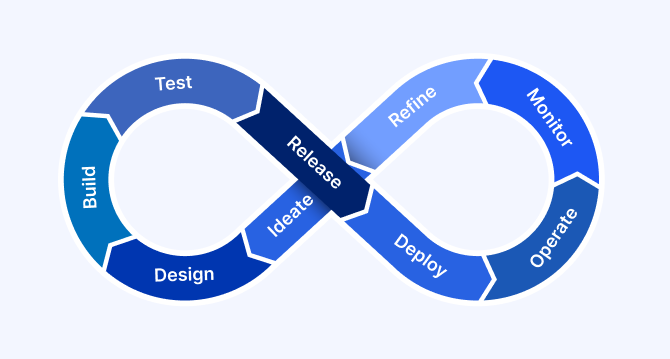
A comprehensive guide to AgentOps: Scope, core practices, key challenges, trends, and ZBrain implementation
AgentOps (agent operations) is the emerging discipline that defines how organizations build, observe and manage the lifecycle of autonomous AI agents.
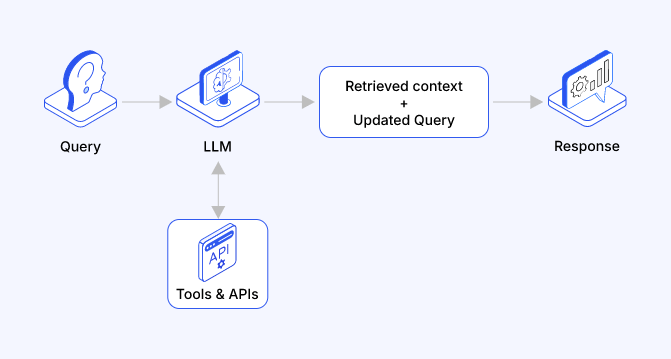
Adaptive RAG in ZBrain: Architecting intelligent, context-aware retrieval for enterprise AI
Adaptive Retrieval-Augmented Generation refers to a class of techniques and systems that dynamically decide whether or not to retrieve external information for a given query.
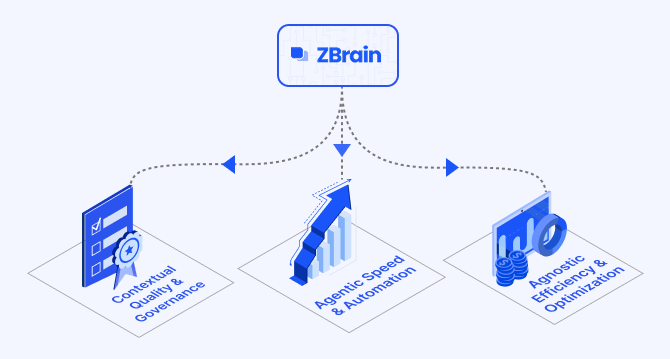
How ZBrain breaks the trade-offs in the AI iron triangle
ZBrain’s architecture directly challenges the conventional AI trade-off model—the notion that enhancing one aspect inevitably compromises another.
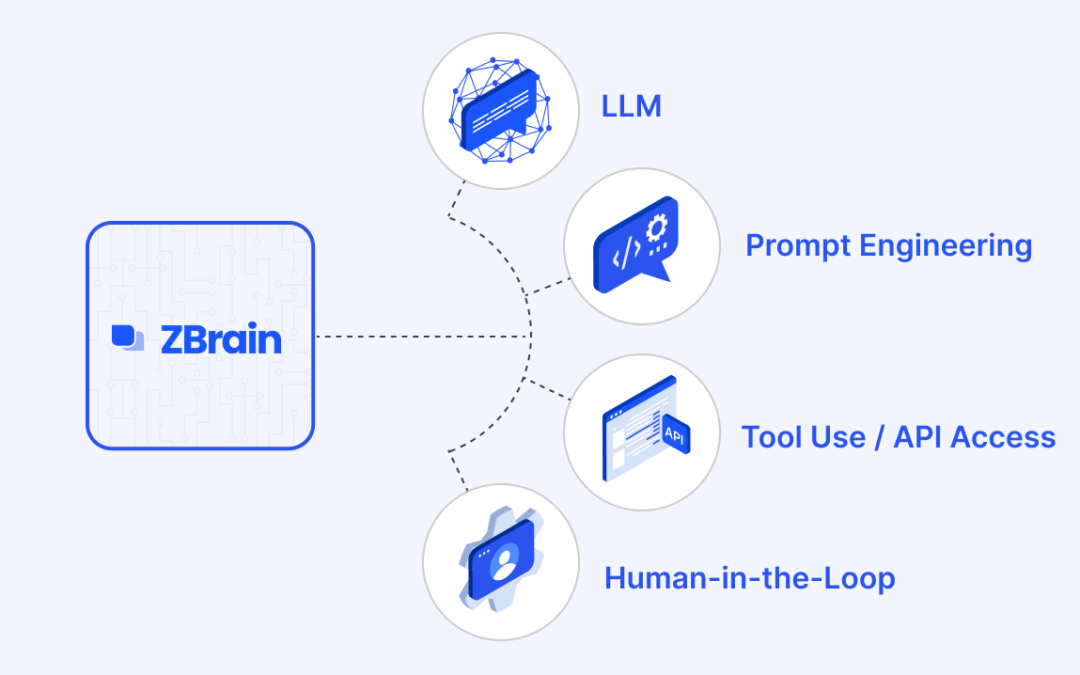
ZBrain Builder’s AI adaptive stack: Built to evolve intelligent systems with accuracy and scale
ZBrain Builder’s AI adaptive stack provides the foundation for a modular, intelligent infrastructure that empowers enterprises to evolve, integrate, and scale AI with confidence.
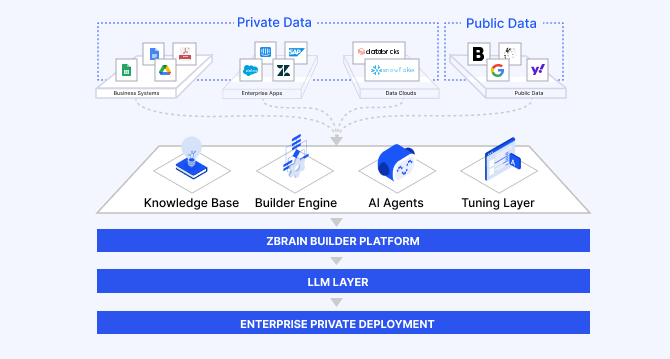
Automated AI workflows with ZBrain: Flows, LLM agents and orchestration patterns
ZBrain enables enterprises to design workflows that are intuitive for teams, efficient in execution, and adaptable to evolving business needs—transforming automation into a strategic advantage.
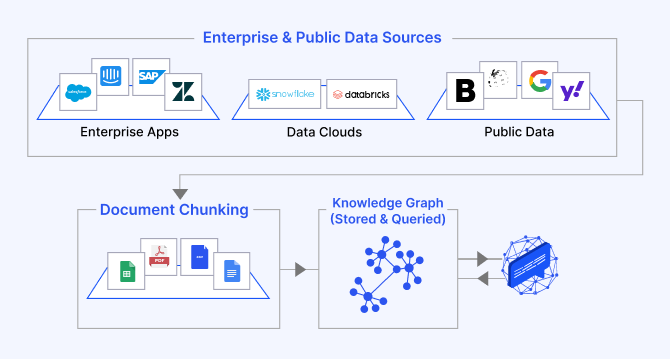
The role of knowledge graphs in building agentic AI systems: Architecture, reasoning, and ZBrain’s implementation
ZBrain Builder leverages knowledge graphs to improve contextual precision and enable reliable multi-hop reasoning in its agent responses.
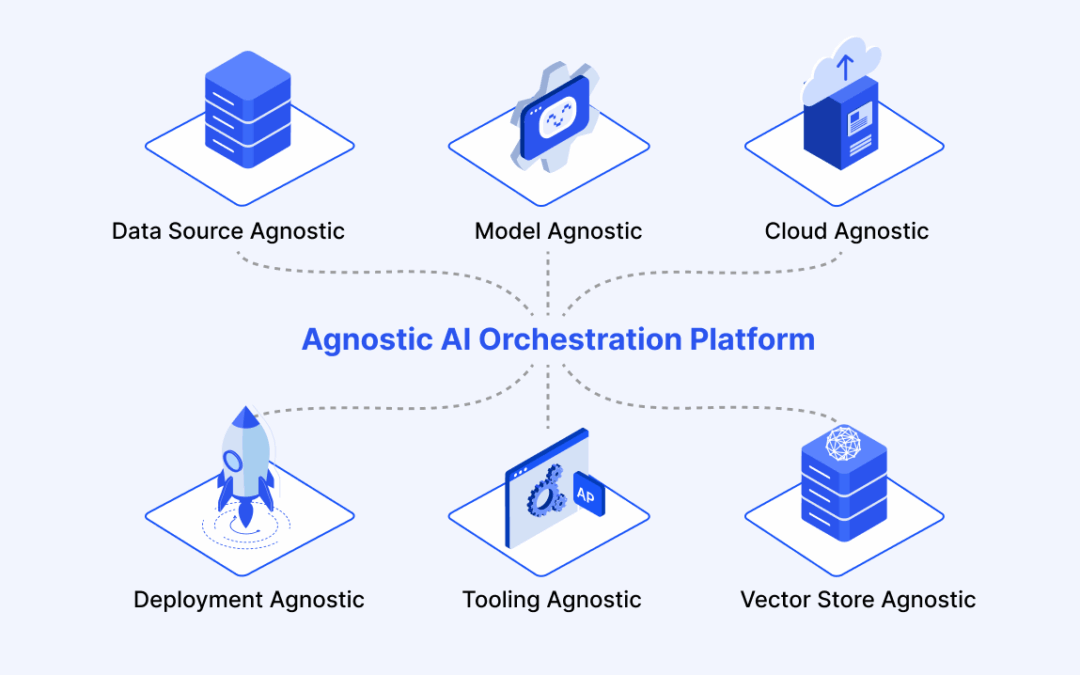
ZBrain Builder: The agnostic agentic AI platform redefining enterprise AI orchestration
ZBrain Builder simplifies many aspects of AI development through its low-code interface and agnostic integration capabilities, maximizing its value depends on thoughtful planning across deployment, configuration, governance, and integration.
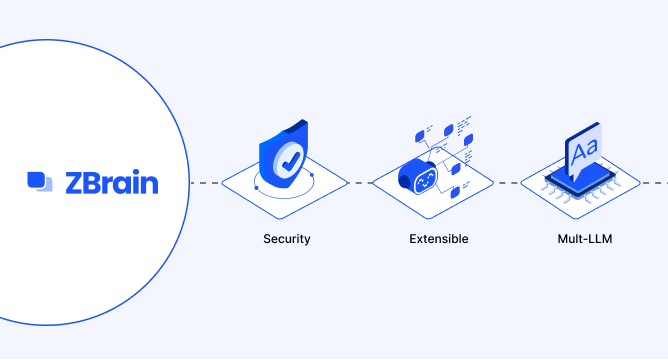
How ZBrain Builder accelerates enterprise delivery with low-code development
Low-code development and generative AI are two transformative forces that converge in ZBrain Builder to create a potent platform for enterprise innovation.
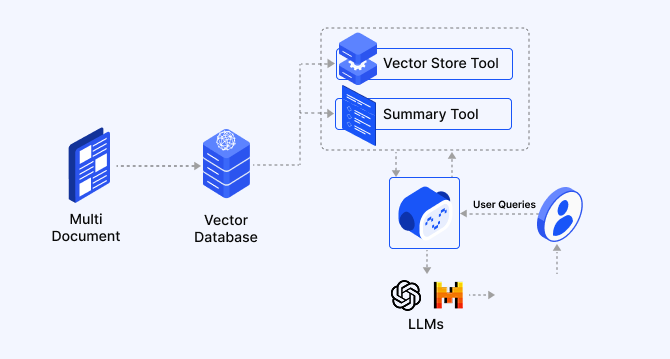
Agentic RAG in ZBrain: How intelligent retrieval is powering enterprise-ready AI
Discover how agentic RAG evolves AI retrieval into a dynamic, reasoning-driven workflow with ZBrain, uniting LLM intelligence and orchestration for accuracy.







